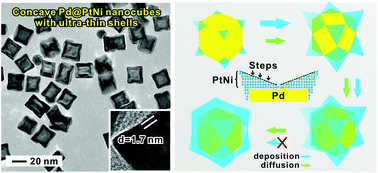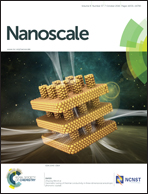Structural evolution of concave trimetallic nanocubes with tunable ultra-thin shells for oxygen reduction reaction†
Abstract
For the large-scale commercial application of Pt-based catalysts, minimizing the usage of Pt while retaining the high catalytic activity is crucial. The fabrication of Pd@Pt core–shell structures, good control of surface atom arrangement, and the formation of an alloy structure with 3d transition metals have been approved as efficient approaches to address this issue; however, it remains a challenge to meet all these three requirements. This paper describes a facile green route for preparing concave Pd@PtNi catalysts with controllable structural evolution. The concavity and thickness of the shells could be controlled by tuning specific experimental parameters. We quantitatively analyzed the deposition rate and diffusion rate of adatoms and found that the concave surfaces of Pd@PtNi nanocrystals were due to the distinct atom deposition and diffusion rate. The as-prepared concave Pd@PtNi nanocubes exhibited greatly enhanced catalytic activities (e.g., oxygen reduction reaction) and durability than commercial Pt/C catalysts. DFT calculations further suggest that, the cooperated Ni reduced the adsorption strength of OH, resulting in the enhancement of the electrochemical properties. These results provided an attractive strategy for designing catalysts with controllable morphology and composition by depositing active metals as ultrathin shells.

- This article is part of the themed collection: 2016 Nanoscale HOT Article Collection


 Please wait while we load your content...
Please wait while we load your content...